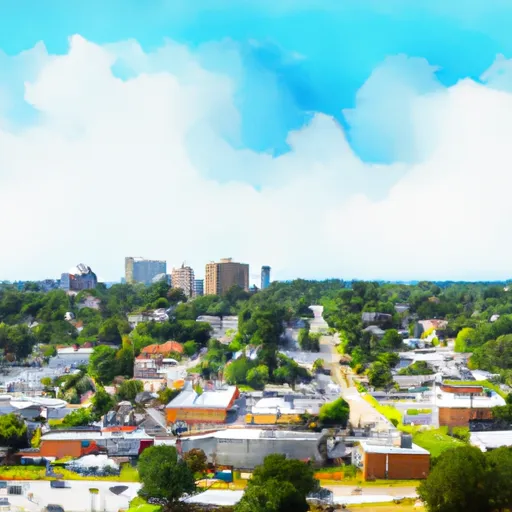-
 Snoflo Premium
Snoflo Premium
Get unlimited access to all our content
With no Ad interruptions! - Start Your Free Trial Login with existing account
Putnam-Hall
Eden Index
Climate
7.5
•
Recreation
4.5
•
Community
•
Safeguard
4.6/10

Putnam-Hall is a small unincorporated community located in Putnam County, Florida. Situated in the northeastern part of the state, its climate is characterized as a humid subtropical climate, with mild winters and hot, humid summers. The average temperature ranges from 50°F (10°C) in winter to 90°F (32°C) in summer, with occasional rainfall throughout the year.
Hydrologically, Putnam-Hall is surrounded by numerous lakes and rivers, making it an ideal destination for water enthusiasts. Some notable hydrology constituents in the area include Lake George, Crescent Lake, and the St. Johns River, which offer opportunities for boating, fishing, and other water-based activities. The region's abundant aquatic ecosystems also support diverse wildlife, making it a haven for birdwatching and nature photography.
Outdoor recreation opportunities in Putnam-Hall extend beyond water-related activities. The community is surrounded by picturesque forests and natural areas, providing excellent opportunities for hiking, camping, and wildlife observation. The Ocala National Forest, located just a short drive away, offers extensive trails for horseback riding, off-roading, and hiking. Putnam-Hall's natural beauty and recreational offerings make it an attractive destination for outdoor enthusiasts seeking to explore Florida's diverse landscapes.
What is the Eden Index?
The Snoflo Eden Index serves as a comprehensive rating system for regions, evaluating their desirability through a holistic assessment of climate health, outdoor recreation opportunities, and natural disaster risk, acknowledging the profound impact of these factors on livability and well-being.
Climate Health Indicator (CHI): 7.5
Putnam-Hall receives approximately
1315mm of rain per year,
with humidity levels near 89%
and air temperatures averaging around
21°C.
Putnam-Hall has a plant hardyness factor of
9, meaning
plants and agriculture in this region tend to thrive here all year round.
By considering the ideal temperature range, reliable water supplies, clean air, and stable seasonal rain or snowpacks, the Climate Health Indicator (CHI) underscores the significance of a healthy climate as the foundation for quality living.
A healthy climate is paramount for ensuring a high quality of life and livability in a region, fostering both physical well-being and environmental harmony. This can be characterized by ideal temperatures, reliable access to water supplies, clean air, and consistent seasonal rain or snowpacks.
Weather Forecast
Streamflow Conditions
St. Johns
Area Rivers
St. Johns
Snowpack Depths
St. Johns
Reservoir Storage Capacity
St. Johns
Groundwater Levels
Recreational Opportunity Index (ROI): 4.5
The Recreational Opportunity Index (ROI) recognizes the value of outdoor recreational options, such as parks, hiking trails, camping sites, and fishing spots, while acknowledging that climate plays a pivotal role in ensuring the comfort and consistency of these experiences.
Access to outdoor recreational opportunities, encompassing activities such as parks, hiking, camping, and fishing, is crucial for overall well-being, and the climate plays a pivotal role in enabling and enhancing these experiences, ensuring that individuals can engage in nature-based activities comfortably and consistently.
Camping Areas
| Campground | Campsites | Reservations | Toilets | Showers | Elevation |
|---|---|---|---|---|---|
| Fore Lake | 100 | 82 ft | |||
| Lake Eaton | 22 | 45 ft | |||
| Gores Landing County Park | None | 31 ft | |||
| Big Scrub | 50 | 145 ft | |||
| Big Bass | 34 | 69 ft | |||
| Lake Delancy | 28 | 30 ft | |||
| Lake Griffin State Rec Area | None | 85 ft | |||
| Santos Rec Area State Park | 24 | 74 ft | |||
| Silver River State Park | 59 | 63 ft | |||
| Withlacoochee River Park | 10 | 94 ft |
Catastrophe Safeguard Index (CSI):
The Catastrophe Safeguard Index (CSI) recognizes that natural disaster risk, encompassing floods, fires, hurricanes, and tornadoes, can drastically affect safety and the overall appeal of an area.
The level of natural disaster risk in a region significantly affects safety and the overall livability, with climate change amplifying these risks by potentially increasing the frequency and intensity of events like floods, fires, hurricanes, and tornadoes, thereby posing substantial challenges to community resilience and well-being.
Community Resilience Indicator (CRI):
The Community Resilience Indicator (CRI) recognizes that education, healthcare, and socioeconomics are crucial to the well-being of a region. The CRI acknowledges the profound impact of these elements on residents' overall quality of life. By evaluating educational resources, healthcare accessibility, and economic inclusivity, the index captures the essential aspects that contribute to a thriving community, fostering resident satisfaction, equity, and social cohesion.

